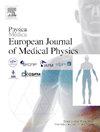Multicatheter-guided rigid registration for high-dose-rate interstitial brachytherapy for mobile tongue cancer
IF 3.3
3区 医学
Q1 RADIOLOGY, NUCLEAR MEDICINE & MEDICAL IMAGING
Physica Medica-European Journal of Medical Physics
Pub Date : 2025-04-22
DOI:10.1016/j.ejmp.2025.104981
引用次数: 0
Abstract
Purpose
We aimed to develop a multicatheter-guided rigid registration (MCgRR) to assess the displacement of catheters and changes in distance between neighboring catheters of high-dose-rate (HDR) interstitial brachytherapy (ISBT) for mobile tongue cancer.
Methods
We analyzed two cases of mobile tongue cancer treated by the HDR ISBT with a two-step method, with the first plan on the initial computed tomography (CT) (P1) and the second plan created on the CT images acquired on the third day (P2). An in-house software of the MCgRR to fit P2 to P1 was developed using Python. Transverse shift (TS) to the mean catheter direction of each catheter and the change in the inter-catheter distance () for neighboring catheters were analyzed.
Results
The TS and were successfully calculated as a function of Z, which is the longitudinal direction along the catheters. The maximum TS was 2.0 and 3.4 mm for Cases #1 and #2, respectively. Visualized TS was found useful for identifying the location of specific areas with large deformation. The was also successfully calculated as a function of Z and ranged from −1.8 to 1.3 mm for Case #1 and from −1.8 to 2.5 mm for Case #2.
Conclusion
The MCgRR developed in this study demonstrated sufficient performance in visualization and identification of areas with large deformation of the CTV in HDR ISBT for mobile tongue cancer.
多导管引导下高剂量率间质近距离治疗舌癌的刚性登记
目的我们旨在开发一种多导管引导的刚性套准(MCgRR),以评估移动性舌癌高剂量率(HDR)间质近距离放射治疗(ISBT)导管的位移和相邻导管之间距离的变化。方法我们分析了两例通过 HDR ISBT 治疗移动性舌癌的病例,采用了两步法,第一步计划基于最初的计算机断层扫描(CT)(P1),第二步计划基于第三天获得的 CT 图像(P2)。使用 Python 开发了一个 MCgRR 内部软件,用于将 P2 与 P1 进行拟合。分析了每根导管平均导管方向的横向移动(TS)以及相邻导管间距(ΔICD)的变化。1 号和 2 号病例的最大 TS 分别为 2.0 毫米和 3.4 毫米。可视化 TS 有助于确定大变形特定区域的位置。本研究中开发的 MCgRR 在移动舌癌 HDR ISBT 的可视化和识别 CTV 大变形区域方面表现出色。
本文章由计算机程序翻译,如有差异,请以英文原文为准。
求助全文
约1分钟内获得全文
求助全文
来源期刊
CiteScore
6.80
自引率
14.70%
发文量
493
审稿时长
78 days
期刊介绍:
Physica Medica, European Journal of Medical Physics, publishing with Elsevier from 2007, provides an international forum for research and reviews on the following main topics:
Medical Imaging
Radiation Therapy
Radiation Protection
Measuring Systems and Signal Processing
Education and training in Medical Physics
Professional issues in Medical Physics.

 求助内容:
求助内容: 应助结果提醒方式:
应助结果提醒方式:


